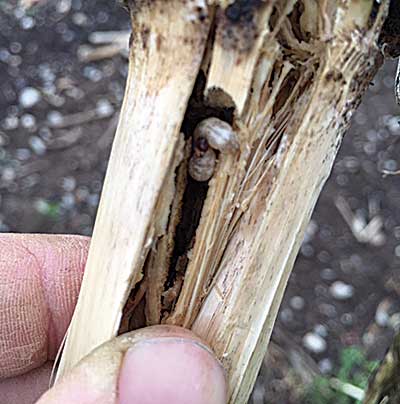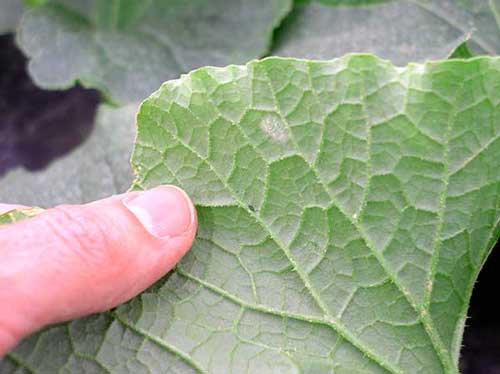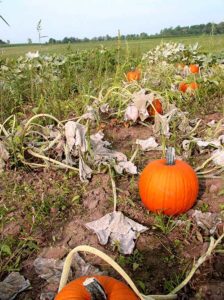With the summer’s warm weather, growing degree days have accumulated more quickly then previously, and pests like european corn borer will be flying earlier than last year.
I am not yet aware of powdery mildew showing up in cucurbits in Maine, but it is only a matter of time, and prevention at the first sight of it is more effective than trying to treat after it takes off.
European Corn Borer in Peppers (among others)
Powdery Mildew in Cucurbits
 |
| European corn borer larva overwintering in a corn stalk |
EUROPEAN CORN BORER IN PEPPERS (among others)
Despite the name, European corn borer (Ostrinia nubilalis) can be found in over 200 different crop and weed plants, not just corn. Other crops that they can be found in include peppers, beans, potatoes, hemp, mums and sometimes even tomatoes. A few other caterpillar pests of sweet corn will also get into some of these same crops – for example, fall armyworm I found in sweet peppers in 2018 – and ‘corn earworm’ has also earned itself the names ‘tomato fruitworm’ and ‘cotton bollworm’. We’ll focus on peppers here, though the information is transferable to other crops as well.
European corn borer overwinter as larvae in crop debris, emerging as adults in the spring. Those adults fly, mate, and typically lay egg masses in early corn at 450 growing degree days (typically June in Maine). The following first generation of the year can themselves begin flying as adults around 1400 growing degree days, and laying eggs around 1450 growing degree days (Southern Maine has just recently exceeded this growing degree day point, so first generation European corn borer are potentially laying egg masses now). This second egg laying generation of the season is typically the one that can cause trouble in peppers and other crops.
Damage in peppers can be difficult to notice at first as the caterpillar only makes a small entry hole near the stem. The most obvious sign of an entry point is the small pile of frass that is left behind. Apart from potentially picking peppers with caterpillars inside them, the real damage occurs when soft rot bacteria and water make their way into the pepper through the hole that the caterpillar bored into the top.
European corn borer is a minor, or even non-existent pest of peppers for many, but where populations build up (often where farms are more densely located), and produce two generations, it can cause significant losses. If it has been an issue for you previously, consider pheromone traps to monitor for egg-laying flights of the adults.
An important cultural control is to remove or plow under crop debris that contains overwintering larvae. Insects that prey on European corn borer eggs and/or larvae include Trichogramma wasp species, and twelve spotted ladybeetles. If monitoring of adult moths shows sufficient pressure, effective spray options include Bt and spinosad products.
Source materials, and more information can be found here:
https://ag.umass.edu/vegetable/fact-sheets/european-corn-borer
https://www.omafra.gov.on.ca/IPM/english/peppers/insects/eurpean-corn-borer.html#advanced
and monitoring and bio-control information is discussed further here:
 |
| Early sign of powdery mildew |
 |
| Effects of powdery mildew late in the season |
POWDERY MILDEW OF CUCURBITS
Powdery mildew is a common disease of pumpkins and winter squash. All cucurbits are susceptible, but many common cucumber and melon varieties are resistant. The disease can cause infected leaves to die prematurely, reducing yields and lowering fruit quality, especially taste. Winter squash from diseased plants won’t store as long as fruits from healthy plants. The fungus that causes the disease does not overwinter in Maine – spores blow up every year from southern overwintering sites. If they arrive late in the season, you may not need any control; but if they arrive in early to midsummer, exercise some control or you may have no leaves by mid-August, or bland starchy squash.
I have not seen any yet, but it’s good to scout regularly. Check upper and lower surfaces of leaves of older plants every few days starting now. The first symptoms usually are white, powdery fungal patches on the undersides of older leaves. Yellow spots may form opposite these, on the upper leaf surfaces.
No products with systemic activity (products that move through the plant) are approved for organic production, and applying fungicide to the lower leaf surface is difficult. In experiments, foliar applications of sulfur (such as Microthiol disperss) have been more effective than most other organic products for powdery mildew, apparently because sulfur deposited on the upper leaf surface can volatilize and be redistributed to the lower surface. Sulfur can be phytotoxic on melons, however, especially if applied when temperatures are hot.
There are some new products made from potassium bicarbonate (Kaligreen and Milstop are two of these) that are showing good efficacy. For a good discussion of these, including efficacy, see the new edition of the Resource Guide to Organic Insect and Disease Management. Potassium bicarbonate combined with a horticultural oil (such as JMS stylet oil) has been shown to be more effective than either product alone. Several bio-fungicide products are available as well.
